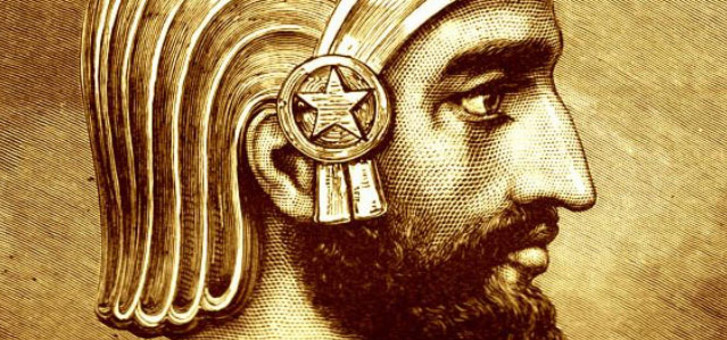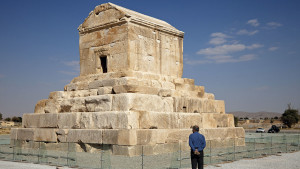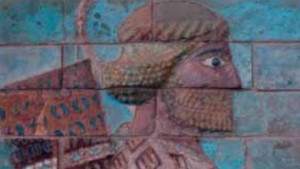From Cyrus to Alexander by Pierre Briant (published 2002 at Winona Lake, Indiana, USA by Eisenbraums; ISBN 1-575506031-0) is an exhaustive analysis of all the known evidence from the period of Cyrus the Great down to the conquest of the Persian Empire by Alexander the Great. It is an awesome accumulation of all known information about this period, but it is not for the casual reader. It consists of 1196 pages of fine print, some finer than others, and every king and courtier comes under scrutiny. Actually it is not quite correct to say that
there are 1196 pages, because the last 319 constitute the most voluminous bibliography likely to be found in any academic book. This includes examination and explanation of source materials, listing of sources, six pages of abbreviations used, and indices of names and topics.
Unfortunately for Briant and other historians, source material is scarce. Surprisingly, “The Persians left no written testaments of their own history, in the narrative sense of the word” (p. 5). They must have had them of course, because when Xerxes could not sleep one memorable night, “one was commanded to bring the book of the records of the chronicles; and they were read before the king” (Esther 6:1). But apparently none of these chronicles have survived.
The nearest approach to a narrative record is the trilingual inscription left by Darius I on the face of the rock in the Zagros Mountains near the tiny tea shop at Bisitun. Today it is known as the “Behistun Rock.”
Thousands of cuneiform tablets have been unearthed in Iran and Babylonia but these are not narrative records. They contain names of kings and officials, dates of events, figures on trade, possessions and numbers of personnel, but it is a huge task analysing these and fitting them into a historical and chronological sequence.
In 1936-8 and 1993-4, American excavators discovered thousands of tablets in Persepolis. They list foodstuffs issued to workmen, rations to travellers and craftsmen who helped build Persepolis. They were mostly written in the Elamite script. 500 seals were found impressed on them. Hundreds of them have still not been published and could contain more valuable information, but none of them include historical narrative. (p.422).
So Briant is reduced to gleaning his information “from the writings of their subjects and their enemies.” (p.7). Their enemies were mostly Greek authors, and many of their subjects were the people described in the Bible books of Esther, Ezra and Nehemiah. The author discards or questions much of what was written by the Greek historians because of their anti Persian prejudices, or because of their historical inaccuracies. That leaves us only with Briant’s conclusions, which are generally sound but not necessarily infallible.
The French edition of this book was first published in 1996 but the English translation only appeared in 2002. Briant’s attention to every known minute detail is impressive. He has apparently made the topic his life study, though he admits that “in no way am I a specialist in any of these languages” (p.4)—that is the Old Persian, Elamite, Babylonian and other languages from which he draws his information. That is understandable because he lists 13 languages from which his source material comes. He first planned the book in 1979 and finally wrote it between the years 1990 and 1993.
Briant admits therefore that “It is necessary, then, at each step, to distinguish the kernel of Achaemenid facts from the Greek interpretation- not always an easy task... But historians cannot choose their sources: given the available evidence, we have no choice but overwhelming reliance on Greek historiography to reconstruct a narrative thread” (pp.6,7). (Achaemenes was the great-great-grandfather of Cyrus)
Although often wearisome reading, Briant’s approach is refreshing. None of the usual “we now know” or the boring repetition of “known facts” handed down for generations. Every minute detail comes under minute scrutiny in Briant’s microscopic search for reality. He spares nobody.
Anyone looking for a sequential history of Medo-Persia will be disappointed in this book. In many areas it is rambling and disjointed, especially in some of the closing chapters. The author is easily sidetracked into lengthy discourses on many obscure aspects of history. The result is sometimes inevitable repetition as aspects of history are discussed under diverse headings, and in the process some contradiction, as when he called Stateira the daughterin-law of Parysatis, (p.613), and her sister-in-law, (p.775). But the overall result is fascinating, and sometimes disturbing reading.
Briant critically and mercilessly analyses every minute detail of recorded history. He is unsparing of the Greek authors Strabo, Herodotus Xenophon, Pausanius, Ctesius, Arrian, Aelian, Plutarch, Diodorus, and Thucydides, though he concedes that “among these authors, there is one who holds a special, pre-eminent place: Herodotus. In contrast to most of his contemporaries, he shows no evidence of systematic hostility to the Persians” (p.7). That is quite a concession in view of the
mindless and oft repeated assertion by some that Herodotus was not the “father of history” as originally claimed, but the “father of lies.”
Recent discoveries have thrown light on Persian history, and no doubt more written records will be discovered in the future. “A written document of the greatest importance was discovered there [Lycia] in 1973: a stela with a text in three versions—Aramaic, Lycian, and Greek, that immediately became famous. It is securely dated to the first year of Artaxerxes IV (338-336), a king of whom virtually nothing was known until then” (p.9).
He makes no profession of belief in the inspiration of biblical history. Infact there are hesitant questions raised about two Bible records for the times involved, but generally speaking there is a remarkable lack of criticism of biblical history of the Persian period. Briant apparently finds them historically reliable, consistent with known facts, and a source for original information.
The Origins of the Empire
The Medo-Persian empire was unique in many respects. The Iranian people were one of the latest on the Middle East scene. Unlike the Babylonians and Assyrians, whose origins can be traced back to the beginning of history in the region, the Aryans were comparatively late arrivals having migrated from southern Europe at an unknown date.
It was an unusual combination of peoples, with the Medes being dominant in the early stages and the Persians assuming dominance in the later stages. This is reflected in the casual biblical references to “the Medes and Persians” (Daniel 5:28), but later to “the laws of the Persians and the Medes” (Esther 1:19). But a remarkable harmony was maintained throughout their history. Reliefs in Persepolis and elsewhere depict Medes and Persians alternately side by side.
Suddenly they emerge onto the world scene. The first Bible reference to Persia is not made until 539 BC where “the reign of the kingdom of Persia” is introduced (2 Chron 36:20). Then came a period of unprecedented opulence and power which lasted for 208 years, and just as suddenly disappeared after their conquest by Alexander the Great.
The extent of the kingdom was also unprecedented. The kingdoms of Assyria and Babylon extended from the shores of the Mediterranean to the hills of Media, but the Medo-Persian Empire extended “from India to Ethiopia (Sudan)” (Esther 1:1) and included Asia Minor (Turkey) and Macedon in Europe. And all this must be attributed to Cyrus whose conquest of Babylon was predicted by the prophet Isaiah nearly 200 years earlier (Isaiah 45).
Briant seems almost incredulous as he asks, “How can we explain this sudden outburst into history by a people and state hitherto practically unknown? How can we explain not only that this people could forge military forces sufficient to achieve conquests as impressive as they were rapid but also that, as early as the reign of Cyrus, it had available the technology and intellectual equipment that made the planning and building of Pasargadae possible?” (p.13).
There are several stories about the birth of Cyrus and no certainty about
the truth of any of them, but the observer would have to agree that he seemed to have been born to be king. A cuneiform cylinder found in the Ishtar Gate at Babylon gives Cyrus’ version of his origins. He states that he was “Son of Cambyses, Great King, king of Ansan, great-grandson of [or descendant] of Teispes, Great King, king of Ansan, from a family [that has] always [exercised] kingship” (p.17).
The Medes were the first on the scene when they allied with the Babylonians in the conquest and destruction of Nineveh in 612 BC, but young Cyrus made war against the Medes about 550 BC. From then on the Persians held the upper hand. Herodotus wrote that the Persians became “masters of the Medes though they were once their slaves.” (p.33). But Cyrus reconciled them by marrying Amytis the daughter of the Median king Astyages, and the Median capital Ecbatana (now Hamadan) continued to be one of the residences of the great Persian kings
And as the author asks, “Was it not in Ecbatana, after all, that at the time of Darius a copy of the edict of Cyrus regarding the return of the Judahites to Jerusalem was found?” “Then King Darius issued a decree, and a search was made in the archives, where the treasures were stored in Babylon, and at Achmetha [Ecbatana] in the province of Media, a scroll was found” (Ezra 6:1,2), and there follows a record of the decree Cyrus issued allowing the Jews to go back to their homeland.
However, although we have much information concerning the events in the life of Cyrus, we are woefully deficient when it comes to dates and that is serious, for, as in Egyptian history, correct dating is vital. “Analysing the strategy of Cyrus, however, requires at the very least that we know its stages, which is far from the case. On the contrary, the chronology of the reign of Cyrus remains uncertain, to say the least. Bearing in mind that the date of the capture of Ecbatana continues to be problematic (within a year or two) only two events are precisely dated: the capture of Babylon (539) and the death of Cyrus in Central Asia (530)” (p.34).
It was not only the military successes of Cyrus that were so important, it was his political policies that set a precedent which his successors wisely followed. The Assyrians pursued a rule of terror to keep their subject nations under control. Submit or face the consequences, which could include impaling or skinning alive.
The Babylonians were more tolerant. They took leading young men captive and tried to indoctrinate them with the Babylonian lifestyle and religion. “The king instructed Ashpenaz, the master of the eunuchs, to bring some of the children of Israel and some of the king’s descendants and some of the nobles, young men in whom there was no blemish, but good-looking, gifted in all wisdom, possessing knowledge and quick to understand, who had ability to serve in the king’s palace, and whom they might teach the language and literature of the Chaldeans” (Daniel 1:3,4). No doubt the object of this exercise was to later appoint them as delegates to their own nations, who would act in the interests of the Babylonians.
The Persians were even more tolerant, not because they were more
sympathetic to captured people, but because it was their political policy of appeasement, to render captive people more content and likely to cooperate with their Persian masters. Hence, “Cyrus felt the need to seek the good will of the local sanctuaries—a policy that he followed in Babylon and that his successors were later to extend throughout the empire” (p.38).
The Cyrus Cylinder
The Cyrus Cylinder states, “I am Cyrus, king of the world, great king, legitimate king, king of Babylon, king of Sumer and Akkad, king of the four rims of the earth... All the kings of the entire world from the upper to the lower sea... brought their heavy tribute and kissed my feet... I returned to [these] sacred cities on the other side of the Tigris, the sanctuaries of which have been ruins for a long time, the images which used to live therein and established for them permanent
sanctuaries. I [also] gathered all their [former] inhabitants and returned [to them] their habitations” (The Ancient Near East, vol 1, p.207).
This is consistent with the decree of Cyrus recorded in Ezra 1:1-3: “The Lord stirred up the spirit of Cyrus king of Persia, so that he made a proclamation throughout all his kingdom, and also put it in writing, saying, ‘Thus says Cyrus king of Persia: All the kingdoms of the earth the Lord God of heaven has given me. And he has commanded me to build him a house in Jerusalem which is in Judah. Who is there among you of all his people? May his God be with him! Now let him go up to Jerusalem, which is in Judah, and build the house of the Lord God of Israel.’” .
This was totally different to the Babylonian policy, at least that of its last king Nabonidus. “In the ‘Cylinder’ Nabonidus is presented as an impious king: he deported the divine statues, the worship of Marduk, the king of the gods, he made it fall into oblivion” (p.40). Yet the author makes the surprising claim that the Persians not only continued the previous policy of the Assyrians and Babylonians of sending captive nations into exile but actually surpassed them in this practise. “Much more than under the NeoAssyrian and Neo-Babylonian kings, peoples or groups of people moved or were moved from one place to another within the empire” (p.505).
The fall of Babylon with its massive double walls to the armies of Cyrus must have sent shock waves around the Babylonian empire. According the story of the “writing on the wall” recorded in Daniel 5, Babylon fell on the occasion of a drunken feast over which Belshazzar, the son of Nabonidus, presided. “Then they brought the gold vessels that had been taken from the temple of the house of God which had been in Jerusalem; and the king and his lords, his wives, and his concubines drank from them. They drank wine and praised the gods of gold and silver, bronze and iron, wood and stone” (Daniel 5:3,4).
They were well aware that the army of Cyrus had encircled their walls, but they were oblivious to the threat, confident in the strength of their walls and the vigilance of their armies. “Herodotus notes that the Babylonians had stockpiled provisions that would allow them to hold out for several years. Like Xenophon he describes the problems faced by Cyrus, who was unable to take a powerfully fortified town defended by troops resolutely determined to resist. Diverting the waters of the Euphrates enabled a small company, led by Ugbaru, to march up the shallow river bed and take advantage of the fact that the Babylonians were then celebrating a major festival and had carelessly left smaller water gates open. He surrounded the sanctuary of Esagila and took the strong points. A few days later, Cyrus was able to make his entrance into Babylon in the traditional ceremony.” (p.42).
Cyrus Enters Babylon
Cyrus wrote on his cylinder, “Without any battle, he [the Babylonian god Marduk] made him enter his town Babylon... sparing Babylon any calamity. He delivered into his hands Nabonidus, the king who did not worship him,. All the inhabitants of Babylon as well as of the entire country of Sumer and Akkad, princes and governors, bowed to him [Cyrus] and kissed his feet” (The Ancient Near East, vol 1, p.207).
“That very night Belshazzar, king of the Chaldeans, was slain, and Darius the Mede received the kingdom” (Daniel 5:30). This was not Darius the Persian, but apparently a Median governor whom Cyrus appointed to
control Babylon after Cyrus’ departure. Belshazzar was the son of Nabonidus who had earlier appointed him as coregent of the kingdom.
Strange to say there is a dearth of information about Cyrus’ activities after his conquest of Babylon. “The last ten years of his reign are poorly known,” (p.40), and even how he died is a matter of dispute. Herodotus pens rather a fanciful account which Briant does not seem to take seriously, though he seems to agree that Cyrus did die during his war in Asia (Turkey).
Herodotus told of Cyrus’ war against the Massagetae in Asia who were ruled by a warrior queen named Tomyris. At first the Massagetae defeated the Persians in battle but during their victory celebrations the Persians “fell upon them, killed many, and took an even greater number prisoners, among whom was Spargapises, the son of Tomyris the queen and general of the army."
“When news of the defeat of her army and the capture of her son got through to the queen, she sent a message to Cyrus in the following terms: ‘Glutton as you are for blood, you have no cause to be proud of this day’s work. ... Now listen to me and I will advise you for your good. Give me back my son and get out of my country with your forces intact, and be content with your triumph over a third part of the Massagetae. If you refuse, I swear by the sun our master to give you more blood than you can drink for all your gluttony’” (Herodotus, The Histories quoted on p.126). They were fighting words for anyone, let alone a woman.
The story continues that the son committed suicide and the queen’s army attacked the Persians and routed them, killing Cyrus in the process. Whether this all happened or not, Cyrus was apparently killed at this time, and “after the death of Cyrus in Central Asia, Cambyses succeeded him with no evident difficulty, and he had his father’s body transported to Pasargadae for burial in the tomb that he had prepared beforehand.” (Briant, p.50).






